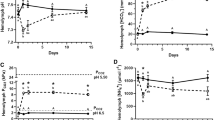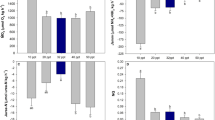Abstract
The hydrothermal vent crab Bythograea thermydron is exposed to high environmental concentrations of sulfide and low levels of oxygen for extended periods of time. It has previously been shown that hydrogen sulfide is oxidized to the relatively non-toxic thiosulfate (S2O 2−3 ), which accumulates in the hemolymph. Hemolymph thiosulfate levels in freshly captured crabs vary significantly among crabs from different hydrothermal vent sites as well as between crabs from different microhabitats within the same site. Hemolymph thiosulfate concentrations were not significantly different between crabs captured at the same site 6 mo apart. Hemolymph thiosulfate concentrations ranged from 66 μmol 1−1 in a crab captured at a site with relatively low sulfide venting, to 3206 μmol 1−1 in an individual that was netted from an active “smoker” vent with much higher sulfide exposure. The differences in hemolymph thiosulfate between sites and the stability of hemolymph thiosulfate in crabs captured at the same site at different times suggest that sulfide exposure is significantly different between sites and that this exposure may not vary significantly over the course of a few months. B. thermydron experimentally exposed to sulfide had high levels of thiosulfate in their hemolymph and increased abilities to regulate oxygen consumption in conditions of low oxygen. This enhancement of regulatory abilities suggests that the previously demonstrated increased hemocyaninoxygen (Hc−O2) affinity due to elevated thiosulfate may be adaptive in vivo. Average oxygen-consumption rates were much higher in crabs experimentally exposed to sulfide than in unexposed crabs. Crabs injected with isosmotic thiosulfate did not have increased oxygen-consumption rates as did the sulfide-exposed individuals, but did show a similar reduction in P c (the critical partial pressure of oxygen at which crabs can no longer regulate oxygen consumption). This suggests that it is the sulfide exposure and/or detoxification rather than the elimination of thiosulfate that causes the increase in metabolic rate. Thiosulfate diffuses into dead crabs and into live crabs exposed to 15 mmol S2O 2-3 l−1, indicating substantial permeability, and yet live crabs are able to eliminate thiosulfate when incubated in sea water containing 1.5 mmol S2O 2-3 l−1, suggesting a process that has an active component.
Similar content being viewed by others
References
Anderson AE, Felbeck H, Childress JJ (1990) Aerobic metabolism is maintained in animal tissues during rapid sulfide oxidation activity in the symbiont-containing clam, Solemya reidi. J exp Zool 256: 130–134
Arp AJ, Childress JJ (1981) Functional chracteristics of the blood of the deep sea hydrothermal vent brachyuran crab. Science, NY 214: 559–561
Arp AJ, Childress JJ (1983) Sulfide binding by the blood of the hydrothermal vent tube worm Riftia pachyptila. Science, NY 219: 295–297
Arp AJ, Childress JJ, Fisher CR Jr (1984) Metabolic and blood gas transport characteristics of the hydrothermal vent bivalve, Calyptogena magnifica. Physiol Zoöl 57: 648–662
Bagarinao T, Vetter RD (1989) Sulfide tolerance and detoxification in shallow-water marine fishes. Mar Biol 103: 291–302
Cavanaugh CM (1985) Symbiosis of chemoautotrophic bacteria and marine invertebrates from hydrothermal vents and reducing sediments. Bull biol Soc Wash 6: 373–388
Childress JJ, Arp AJ, Fisher CR Jr (1984) Metabolic and blood characteristics of the hydrothermal vent tube worm Riftia pachyptila. Mar Biol 83: 109–124
Childress JJ, Fisher CR (1992) The biology of hydrothermal vent animals: physiology, biochemistry, and autotrophic symbioses. Oceanogr mar Biol A Rev 30: 337–441
Childress JJ, Lee RW, Sanders NK, Felbeck H, Oros DR, Toulmond A, Desbruyeres D, Kennicutt MC, Brooks J (1993) Inorganic carbon uptake in hydrothermal vent tubeworms facilitated by high environmental pCO2. Nature, Lond 362: 147–149
Childress JJ, Mickel TJ (1980) A motion compensated shipboard precision balance system. Deep-Sea Res 27: 965–970
Corliss JB, Dymond J, Gordon LI, Edmond JM, Herzen RPV, Ballard RD, Green K, Williams D, Bainbridge A, Crane K, van Andel TH (1979) Submarine thermal springs on the Galapagos Rift. Science, NY 203: 1073–1083
Cowles DL (1987) Factors affecting the aerobic metabolism of midwater crustaceans. Ph.D. dissertation. University of California, Santa Barbara
Fahey RC, Dorian R, Newton GL, Utley J (1983) Determination of intracellular thiol levels using bromobimane fluorescent labeling: applications involving radioprotective drugs. In: Nygaard OF, Simic MG (eds) Radioprotectors and anticarcinogens. Academic Press, New York, p 103–120
Fahey RC, Newton GL (1987) Determination of low molecular-weight thiols using monobromobimane fluorescent labeling and high performance liquid chromatography. Meth Enzym 143: 85–97
Fisher CR (1990) Chemoautotrophic and methanotrophic symbioses in marine invertebrates. CRC critical Rev aquat Sciences 2: 399–436
Johnson KS, Childress JJ, Beehler CL (1988a) Short term temperature variability in the Rose Garden hydrothermal vent field. Deep-Sea Res 35: 1711–1722
Johnson KS, Childress JJ, Hessler RR, Sakamoto-Arnold CM, Beehler CL (1988b) Chemical and biological interactions in the Rose Garden hydrothermal vent field. Deep-Sea Res 35: 1723–1744
Mickel TJ, Childress JJ (1982) Effects of temperature, pressure and oxygen concentration on the oxygen consumption rate of the hydrothermal vent crab Bythograea thermydron (Brachyura). Physiol Zoöl 55: 199–207
Mickel TJ, Quetin LB, Childress JJ (1983) Construction of a polarographic oxygen sensor in the laboratory. In: Gnaiger E, Forstner H (eds) Polarographic oxygen sensors. Springer-Verlag, Berlin, p 81–85
National Research Council (Division of Medical Science, Subcommittee on Hydrogen Sulfide) (1979) Hydrogen sulfide. University Park, Baltimore
Newton GL, Dorian R, Fahey RC (1981) Analysis of biological thiols by derivatization with monobromobimane and separation by reverse-phase high performance liquid chromatography. Analyt Biochem 114: 383–387
Potts WTW, Parry G (1964) Osmotic and ionic regulation in animals. Pergamon Press, Oxford
Powell MA, Somero GN (1986) Hydrogen sulfide oxidation is coupled to oxidative phosphorylation in mitochondria of Solemya reidi. Science, NY 233: 563–566
Sanders NK (1989) Functional properties of hemocyanins from deepsea crustaceans. Ph.D. dissertation. University of California, Santa Barbara
Sanders NK, Arp AJ, Childress JJ (1988) Oxygen binding characteristics of the hemocyanins of two deep-sea hydrothermal vent crustaceans. Respir Physiol 71: 57–68
Sanders NK, Childress JJ (1992) Specific effects of thiosulfate and L-lactate on hemocyanin-O2 affinity in a brachyuran hydrothermal vent crab. Mar Biol 113: 175–180
Vetter RD, Wells ME, Kurtsman AL, Somero GN (1987) Sulfide detoxification by the hydrothermal vent crab Bythograea thermydron and other decapod crustaceans. Physiol Zoöl 60: 121–137
Von Damm KL (1990) Seafloor hydrothermal activity: black smoker chemistry and chimneys. A Rev Earth planet Sciences 18: 173–204
Author information
Authors and Affiliations
Additional information
Communicated by M. G. Hadfield, Honolulu
Rights and permissions
About this article
Cite this article
Gorodezky, L.A., Childress, J.J. Effects of sulfide exposure history and hemolymph thiosulfate on oxygen-consumption rates and regulation in the hydrothermal vent crab Bythograea thermydron . Mar. Biol. 120, 123–131 (1994). https://doi.org/10.1007/BF00381948
Received:
Accepted:
Issue Date:
DOI: https://doi.org/10.1007/BF00381948




